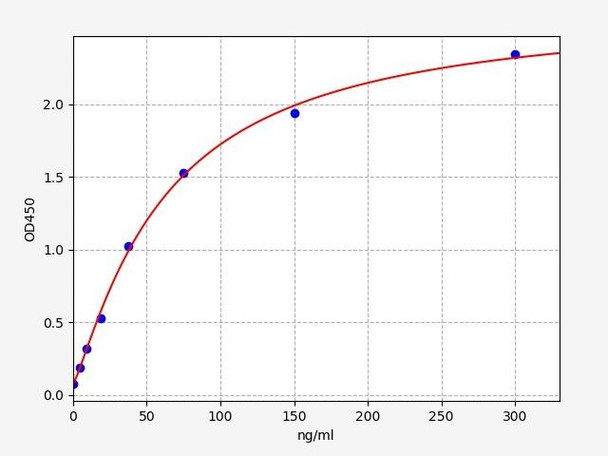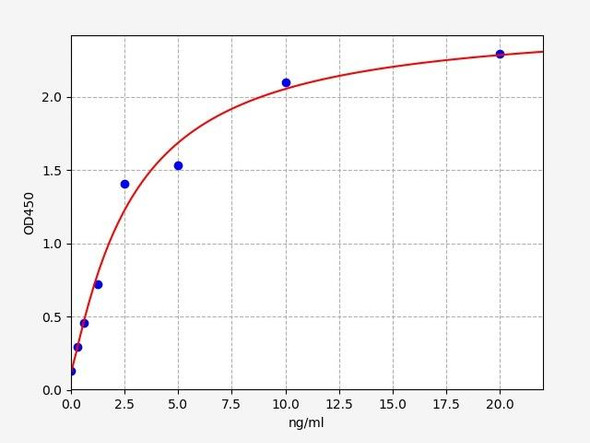Human Anti-Teichoic Acid Antibody ELISA Kit
- SKU:
- HUFI02886
- Product Type:
- ELISA Kit
- Size:
- 96 Assays
- Sensitivity:
- 2.813ng/ml
- Range:
- 4.688-300ng/ml
- ELISA Type:
- Sandwich ELISA, Double Antigen
- Synonyms:
- TA, Anti-Teichoic Acid Antibody
- Reactivity:
- Human
Description
| Product Name: | Human Anti-Teichoic Acid Antibody ELISA Kit |
| Product Code: | HUFI02886 |
| Size: | 96 Assays |
| Alias: | TA, Anti-Teichoic Acid Antibody |
| Detection method: | Sandwich ELISA, Double Antigen |
| Application: | This immunoassay kit allows for the in vitro quantitative determination of Human TA concentrations in serum plasma and other biological fluids. |
| Sensitivity: | 2.813ng/ml |
| Range: | 4.688-300ng/ml |
| Storage: | 4°C for 6 months |
| Note: | For Research Use Only |
| Recovery: | Matrices listed below were spiked with certain level of Human TA and the recovery rates were calculated by comparing the measured value to the expected amount of Human TA in samples. | ||||||||||||||||
| |||||||||||||||||
| Linearity: | The linearity of the kit was assayed by testing samples spiked with appropriate concentration of Human TA and their serial dilutions. The results were demonstrated by the percentage of calculated concentration to the expected. | ||||||||||||||||
| |||||||||||||||||
| CV(%): | Intra-Assay: CV<8% Inter-Assay: CV<10% |
| Component | Quantity | Storage |
| ELISA Microplate (Dismountable) | 8×12 strips | 4°C for 6 months |
| Lyophilized Standard | 2 | 4°C/-20°C |
| Sample/Standard Dilution Buffer | 20ml | 4°C |
| Biotin-labeled Antigen (Concentrated) | 120ul | 4°C (Protect from light) |
| Antigen Dilution Buffer | 10ml | 4°C |
| HRP-Streptavidin Conjugate(SABC) | 120ul | 4°C (Protect from light) |
| SABC Dilution Buffer | 10ml | 4°C |
| TMB Substrate | 10ml | 4°C (Protect from light) |
| Stop Solution | 10ml | 4°C |
| Wash Buffer(25X) | 30ml | 4°C |
| Plate Sealer | 5 | - |
Other materials and equipment required:
- Microplate reader with 450 nm wavelength filter
- Multichannel Pipette, Pipette, microcentrifuge tubes and disposable pipette tips
- Incubator
- Deionized or distilled water
- Absorbent paper
- Buffer resevoir
| Uniprot | O14656 |
| UniProt Protein Function: | TOR1A: May serve as a molecular chaperone assisting in the proper folding of secreted and/or membrane proteins. In the nucleus, displaces the nuclear membrane proteins SUN2, SYNE2 and nesprin-3/C14orf49, leaving nuclear pores and SUN1 unchanged. May form homohexamers. Interacts with TOR1AIP1 and TOR1AIP2. Interacts with KLHL14, preferentially when ATP-free. Widely expressed. Highest levels in kidney and liver. Not detected in spleen. In the brain, high levels found in the dopaminergic neurons of the substantia nigra pars compacta, as well as in the neocortex, hippocampus and cerebellum. Also high expression in the spinal cord. Belongs to the clpA/clpB family. Torsin subfamily. 2 isoforms of the human protein are produced by alternative splicing. |
| UniProt Protein Details: | Protein type:Secreted, signal peptide; Secreted Chromosomal Location of Human Ortholog: 9q34 Cellular Component: synaptic vesicle; transport vesicle; nuclear membrane; growth cone; cytoskeleton; cytoplasmic vesicle membrane; intracellular membrane-bound organelle; membrane; endoplasmic reticulum lumen; nuclear envelope; cell junction; secretory granule Molecular Function:protein binding; kinesin binding; ATPase activity; cytoskeletal protein binding; unfolded protein binding; misfolded protein binding; ATP binding Biological Process: protein deneddylation; chaperone cofactor-dependent protein folding; organelle organization and biogenesis; synaptic vesicle transport; regulation of dopamine uptake; intermediate filament cytoskeleton organization and biogenesis; response to oxidative stress; cell adhesion; nuclear membrane organization and biogenesis; neurite development; protein homooligomerization Disease: Dystonia 1, Torsion, Autosomal Dominant |
| NCBI Summary: | The protein encoded by this gene is a member of the AAA family of adenosine triphosphatases (ATPases), is related to the Clp protease/heat shock family and is expressed prominently in the substantia nigra pars compacta. Mutations in this gene result in the autosomal dominant disorder, torsion dystonia 1. [provided by RefSeq, Jul 2008] |
| UniProt Code: | O14656 |
| NCBI GenInfo Identifier: | 13878817 |
| NCBI Gene ID: | 1861 |
| NCBI Accession: | O14656.1 |
| UniProt Secondary Accession: | O14656,Q53Y64, Q96CA0, B2RB58, |
| UniProt Related Accession: | O14656 |
| Molecular Weight: | 37,809 Da |
| NCBI Full Name: | Torsin-1A |
| NCBI Synonym Full Names: | torsin family 1, member A (torsin A) |
| NCBI Official Symbol: | TOR1A |
| NCBI Official Synonym Symbols: | DQ2; DYT1 |
| NCBI Protein Information: | torsin-1A; torsin ATPase 1; torsin ATPase-1A; dystonia 1 protein; torsin family 1 member A; dystonia 1, torsion (autosomal dominant; torsin A) |
| UniProt Protein Name: | Torsin-1A |
| UniProt Synonym Protein Names: | Dystonia 1 protein; Torsin ATPase-1A (EC:3.6.4.-); Torsin family 1 member A |
| UniProt Gene Name: | TOR1A |
| UniProt Entry Name: | TOR1A_HUMAN |
*Note: Protocols are specific to each batch/lot. For the correct instructions please follow the protocol included in your kit.
Bring all reagents and samples to room temperature 30 minutes before use. When diluting samples and reagents, they must be mixed completely and evenly. It is recommended to plot a standard curve for each test.
| Step | Protocol |
| 1. | Set standard, test sample (diluted at least ½ with Sample Dilution Buffer) and control (zero) wells on the pre-coated plate and record their positions. It is recommended to measure each standard and sample in duplicate. Wash plate 2 times before adding standard, sample and control (blank) wells. |
| 2. | Aliquot 100µl of standard solutions into the standard wells |
| 3. | Add 100µl of Sample / Standard dilution buffer into the control (blank) well. |
| 4. | Add 100µl of properly diluted sample (serum, plasma, tissue homogenates and other biological fluids) into test sample wells. |
| 5. | Seal the plate with a cover and incubate at 37 °C for 90 min. |
| 6. | Remove the cover and discard the plate content, clap the plate on the absorbent filter papers or other absorbent material. Do NOT let the wells completely dry at any time. Wash plate X2. |
| 7. | Add 0.1 ml of Biotin-detection antigen working solution into the above wells (standard, test sample & zero wells). Add the solution at the bottom of each well without touching the side wall. |
| 8. | Seal the plate with a cover and incubate at 37°C for 60 min. |
| 9. | Remove the cover, and wash plate 3 times with Wash buffer. Let wash buffer rest in wells for 1 min between each wash. |
| 10. | Add 0.1 ml of SABC working solution into each well, cover the plate and incubate at 37°C for 30 min. |
| 11. | Remove the cover and wash plate 5 times with Wash buffer, and each time let the wash buffer stay in the wells for 1-2 min. |
| 12. | Add 90 µl of TMB substrate into each well, cover the plate and incubate at 37°C in dark within 10-20 min. (Note: This incubation time is for reference use only, the optimal time should be determined by end user.) And the shades of blue can be seen in the first 3-4 wells (with most concentrated standard solutions), the other wells show no obvious color. |
| 13. | Add 50 µl of Stop solution into each well and mix thoroughly. The color changes into yellow immediately. |
| 14. | Read the O.D. absorbance at 450 nm in a microplate reader immediately after adding the stop solution. |
When carrying out an ELISA assay it is important to prepare your samples in order to achieve the best possible results. Below we have a list of procedures for the preparation of samples for different sample types.
| Sample Type | Protocol |
| Serum | If using serum separator tubes, allow samples to clot for 30 minutes at room temperature. Centrifuge for 10 minutes at 1,000x g. Collect the serum fraction and assay promptly or aliquot and store the samples at -80°C. Avoid multiple freeze-thaw cycles. If serum separator tubes are not being used, allow samples to clot overnight at 2-8°C. Centrifuge for 10 minutes at 1,000x g. Remove serum and assay promptly or aliquot and store the samples at -80°C. Avoid multiple freeze-thaw cycles. |
| Plasma | Collect plasma using EDTA or heparin as an anticoagulant. Centrifuge samples at 4°C for 15 mins at 1000 × g within 30 mins of collection. Collect the plasma fraction and assay promptly or aliquot and store the samples at -80°C. Avoid multiple freeze-thaw cycles. Note: Over haemolysed samples are not suitable for use with this kit. |
| Urine & Cerebrospinal Fluid | Collect the urine (mid-stream) in a sterile container, centrifuge for 20 mins at 2000-3000 rpm. Remove supernatant and assay immediately. If any precipitation is detected, repeat the centrifugation step. A similar protocol can be used for cerebrospinal fluid. |
| Cell culture supernatant | Collect the cell culture media by pipette, followed by centrifugation at 4°C for 20 mins at 1500 rpm. Collect the clear supernatant and assay immediately. |
| Cell lysates | Solubilize cells in lysis buffer and allow to sit on ice for 30 minutes. Centrifuge tubes at 14,000 x g for 5 minutes to remove insoluble material. Aliquot the supernatant into a new tube and discard the remaining whole cell extract. Quantify total protein concentration using a total protein assay. Assay immediately or aliquot and store at ≤ -20 °C. |
| Tissue homogenates | The preparation of tissue homogenates will vary depending upon tissue type. Rinse tissue with 1X PBS to remove excess blood & homogenize in 20ml of 1X PBS (including protease inhibitors) and store overnight at ≤ -20°C. Two freeze-thaw cycles are required to break the cell membranes. To further disrupt the cell membranes you can sonicate the samples. Centrifuge homogenates for 5 mins at 5000xg. Remove the supernatant and assay immediately or aliquot and store at -20°C or -80°C. |
| Tissue lysates | Rinse tissue with PBS, cut into 1-2 mm pieces, and homogenize with a tissue homogenizer in PBS. Add an equal volume of RIPA buffer containing protease inhibitors and lyse tissues at room temperature for 30 minutes with gentle agitation. Centrifuge to remove debris. Quantify total protein concentration using a total protein assay. Assay immediately or aliquot and store at ≤ -20 °C. |
| Breast Milk | Collect milk samples and centrifuge at 10,000 x g for 60 min at 4°C. Aliquot the supernatant and assay. For long term use, store samples at -80°C. Minimize freeze/thaw cycles. |










